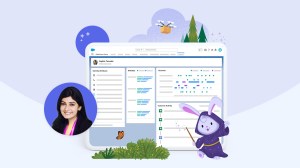Throughout Salesforce’s 24-year history, the company has been on a mission to create a 360-degree view of every customer. With the introduction of Data Cloud, that vision is becoming a reality.
Data Cloud combines existing transactional databases, like CRM, with behavioral data from customers. It also enables companies to process and consolidate vast amounts of data from third-party sources to create a unified customer profile.
Bringing all of this data together forms a foundation for enterprise-wide AI and automation by empowering businesses to create meaningful workflows and actions, such as automated sales prospecting, audience segmentation, and personalized self-service.
This is an exciting prospect for businesses, which is one reason Data Cloud has become the fastest growing home-grown product in Salesforce history. As customer zero, Salesforce is using Data Cloud internally to create one unified profile of its customers.
With Data Cloud, Salesforce now has access to 1.2 billion customer records from over 60 different data streams, including transactions, communication history, service requests, and more. By feeding all of this data into Data Cloud, the company has been able to reduce duplicate records and consolidate over 52% of its customer profiles, which is helping the company achieve a single view of its customers.
With these unified profiles, Salesforce can leverage AI and automation to personalize every interaction, whether the customer is browsing the website, engaging across social channels, or learning news skills on the company’s free online learning platform, Trailhead.
In this interview, Janani Narayanan, Salesforce’s Senior Director of Product Management, gives us a behind-the-scenes look at how the company’s marketing and sales teams are using Data Cloud to drive sales pipeline, increase customer adoption, and create better experiences for all its stakeholders.
Q. How is Data Cloud built?
Before Data Cloud, Salesforce’s suite of products were built to deal with mostly transactional data. The addition of Data Cloud complements our existing transactional database with the ability to take in massive volumes of data from across CRM, web, mobile, APIs, and devices in real time.
Data Cloud stores all this data using a lakehouse architecture, which organizes unstructured data from across the enterprise and makes it easier to access. Like all other Salesforce platform features, Data Cloud is built using Salesforce metadata, meaning all of the data stored there is able to be used across the Customer 360.
Like all other Salesforce platform features, Data Cloud is built using Salesforce metadata, meaning all of the data stored there is able to be used across the Customer 360.
Q. How was Data Cloud developed?
When we realized how much fragmented data we had across our organization, we took an agile, product-driven approach to solve the issue. We began to build out Data Cloud to prove it could work, and decided to test it on ourselves first.
Data Cloud created a persistent, unified, real-time view of each of our customers across sales, service, marketing, and commerce. This gave us access to consent and preferences across all of our customer accounts, and allowed us to automate many processes throughout our organization.
For example, we were able to track when a known prospect was browsing the website and then automatically post a notification to the Account Executive (AE) on Slack so they could follow up. After starting with 20 AEs in the initial pilot, we now have over one-third of Salesforce’s AEs currently using the product and plan to scale it globally. This has saved us over 120 hours of customer conversations and drove millions of dollars in revenue.
Q. What are some of the other ways Salesforce has leveraged Data Cloud internally?
We recently piloted Data Cloud’s new native Google Ads integration internally to transform how we target Sales Cloud and Service Cloud buyers on Google. This new integration allowed us to create segments in Data Cloud and push them to Google in a secure and a privacy-compliant way so our Digital Media team can target and serve the buyers personalized offers.
We proved it works, shared our experience with customers, and we evolved then launched the product with their feedback in mind.
Another place we have been able to take advantage of Data Cloud is with Salesforce+, our streaming service for live events and original content. We connected customer data from marketing, sales, and service with registered profiles from Trailhead. This allowed us to create personalized journeys and push customized content to each viewer, tailored to their favorite Salesforce products, from their very first welcome email. Over 140,000 personalized emails have been sent since we launched, leading to an increase of both average views and time spent on the service.
Q. Why is Data Cloud important for AI?
AI is the most important technology of our lifetime. No question.
However, AI is only as good as the data that fuels it. In fact, 58% of workers say trusted customer data is critical to successfully using generative AI in their role. That’s why Data Cloud is so critical to harnessing AI and automation.
In fact, 58% of workers say trusted customer data is critical to successfully using generative AI in their role.
Data Cloud blends and organizes all of that data together and organizes it, so companies can build AI models on top of it, and it can be used to power every AI-driven customer interaction.
One example of this in action is Einstein Studio, which helps companies use their proprietary company data from Data Cloud to train large language models from Salesforce’s ecosystem of curated AI models, including Amazon SageMaker from Amazon Web Services (AWS), Google Cloud’s Vertex AI, and other AI services. This helps companies build smarter marketing segments and deliver truly personalized experiences out of the box.
Q. What’s ahead for Data Cloud?
Our product teams are hard at work to deliver new connectors for Data Cloud across our entire Customer 360 portfolio, including AppExchange, Service Cloud, and Trailhead, to deliver real-time experiences to anyone who visits our website.
We are also going to create a more seamless Data Cloud integration with third-party ad services to gain new insights into how campaigns are performing and how we can optimize them with first-party data. Currently, there are several connectors, including Google, Meta, and AWS available, but there are so many other platforms that digital marketing teams run campaigns on.
Next month at Dreamforce, we’ll share more about the vision for the next generation of Data Cloud and how it will fuel new AI-powered Einstein GPT innovations.
More information:
- Learn more about Data Cloud
- Read the latest Data Cloud news
- Explore Data Cloud on Trailhead















